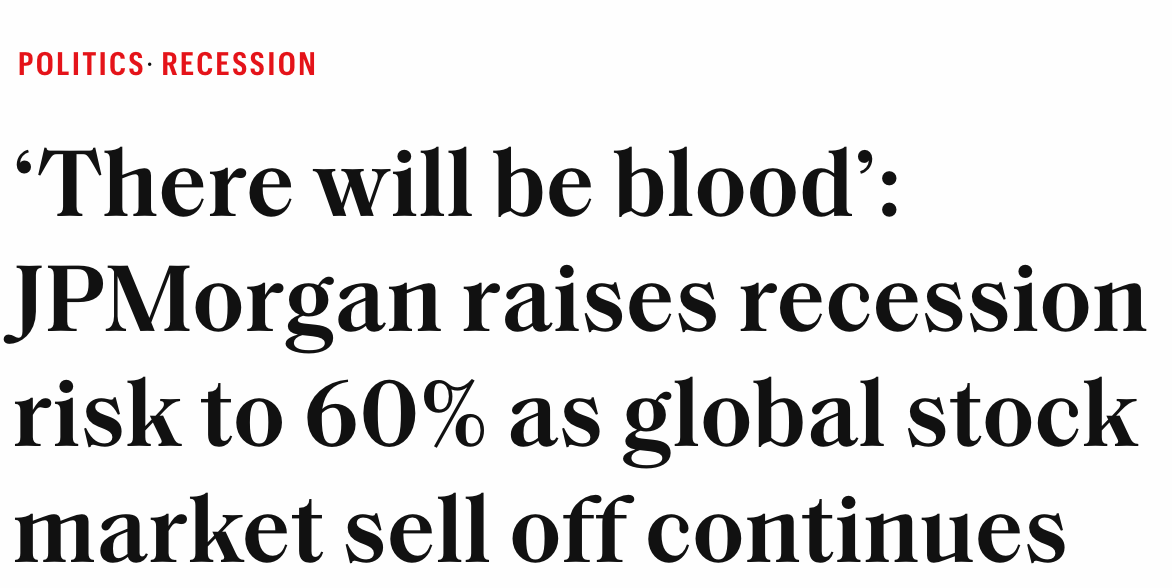The End Of The Market as We Know It
And I feel fine...
Author’s Note: I will continue releasing free content where I can provide value to everyone. Posts will include premium content for paid subscribers at the end of emails or as separate write-ups. Free content will focus on macro views, whereas the paid content will focus more on the tactical trades I’m making.
Serious traders or investors should join Premium to get the best, most timely information.
Tariffs are a highly sensitive subject that sometimes veer into the realm of politics. I’ve decided to avoid the politics entirely in this post and just try to look at the facts of the situation. Please don’t read any of my statements as political—I’m just trying to trade, man.
Well, that was a hell of a week.
Trump came out swinging on Wednesday with much bigger-than-expected tariffs and the market action was about what you would expect.
NDX, SPX, and RTY all closed the week down around 8%. SPX experienced the largest two day drop since March 2020 (COVID).
I talked the previous week about Vol being comparatively cheap. I wrote about buying hedges because of that, and those hedges returned a big number this week.
In the chat I also wrote about getting net short after Trump’s announcement. I took those shorts off too early, but those combined with the hedges actually put my book green on the week.
If you’re not in the chat, I highly recommend subscribing to get those real time notifications directly in your inbox.
If you had a tough week don’t beat yourself up over it. These have been some of the toughest market conditions I’ve seen, tougher than 2020 although maybe not quite as tough as 2022 (yet).
Next week is shaping up to be another important one, so let’s take a look at the landscape and how to play it.
Extreme Bearishness
This looks similarly extreme. US investors have rarely been positioned so negatively relative to other international investors, or at least never since 1990.
- Michael Howell, Capital Wars
Following last week’s sell off US investors are positioned more bearishly than we have seen in a very long time. The exact measures vary from researcher to researcher, but we are at depths not seen since other major crises.
That bearishness makes sense, however, so while it’s a valuable technical indicator it should not be relied on alone to make decisions in these conditions.
Stealing another great chart from Michael Howell it looks like the world is on the verge of falling into a global recession.
In fact, many forecasters are now assuming a recession as a base-case.
If Trump’s trade policies persist, a global recession should be expected.
Therefore the question of the day is:
Will the Tariffs Persist?
This is a much more difficult question to answer than simply “will the tariffs cause a recession,” in part because it spans across a variety of disciplines from psychology, to history, to politics.
In Trump’s EO (Executive Order 14257) he is explicit about his goals and what criteria he is evaluating to set his tariff rates. I’ve pulled some select quotes that are important to understanding him. I’ve bolded the most key parts.
"It is the policy of the United States to rebalance global trade flows by imposing an additional ad valorem duty on all imports from all trading partners except as otherwise provided herein.”
"Specifically, such asymmetry includes not only non-reciprocal differences in tariff rates among foreign trading partners, but also extensive use of non-tariff barriers by foreign trading partners, which reduce the competitiveness of U.S. exports while artificially enhancing the competitiveness of their own goods."
"Should any trading partner retaliate against the United States in response to this action through import duties on U.S. exports or other measures, I may further modify the HTSUS to increase or expand in scope the duties imposed under this order."
"Should any trading partner take significant steps to remedy non-reciprocal trade arrangements and align sufficiently with the United States on economic and national security matters, I may further modify the HTSUS to decrease or limit in scope the duties imposed under this order."
"Should U.S. manufacturing capacity and output continue to worsen, I may further modify the HTSUS to increase duties under this order."
Reading the EO makes this pretty clear. Trump has one primary goal which is to “rebalance global trade flows.” As his main benchmark he is watching “U.S. manufacturing capacity and output.” Should that primary factor “continue to worsen” he may continue to impose additional duties. On the other hand, should a trading partner take “significant steps to remedy non-recpirocal trade arrangements and align sufficiently with the United States on economic and national security matters” then he might “decrease or limit in scope” his tariffs.
We can take him at his word here. He views the deteriorated US industrial base as a national security crisis and he is taking steps to remedy that. He believes tariffs to be the best method, but if other countries can lower trade barriers such that US manufacturing can flourish without his tariffs then he is open to doing so.
If other countries can come up with ways to “align sufficiently with the United States on economic and national security matters” then he might also consider removing tariffs, even at the cost of US manufacturing.
Trump is not interested in solutions that do not bring manufacturing to the US, or significantly strengthen the US’ economic and national security situation.
EU’s Ennui
This puts the world in a very awkward spot. Most of our allies have very low effective tariffs on our goods. The EU is estimated by the WTO to have around a 2.7% tariff rate on US goods.
Therefore the EU’s only option to reduce these tariffs is to look for ways to “align sufficiently with the United States on economic and national security matters.”
What could that look like? I’m not sure but a few ideas:
EU agreeing to buy century “military bonds” from the United States in exchange for continued safety under the US military protection and access to US markets.
The EU agreeing to form an anti-China trading bloc that levies substantial tariffs on China in unison with the United States.
Agreements to up EU military spending and/or industrial production.
It’s unclear to me how likely any of these are as of yet, and non seem particularly likely to happen quickly. Therefore, I have to assume tariffs on the EU will remain for the foreseeable future.
Vietnam as a Test Case
Vietnam is a great example of a country that has tried hard to align itself with the United States as an “alternative to China” and has benefitted by securing large manufacturing contracts with American corporates.
Now, they are being tariffed at 46%.
Vietnam has, as of Sunday, offered to remove all of its’ tariffs on US goods but it’s hard to imagine that helping. Peter Navarro seemed to confirm that, saying:
“If you simply lowered our tariffs and they lowered our tariffs to zero, we’d still run about $120 billion trade deficit with Vietnam,” he said on Fox News’ Sunday Morning Futures. “And the problem is all of the non-tariff cheating that they do.”
Vietnam has no reasonable way to bring down that trade deficit. A poor country, Vietnam is unlikely to find realistic ways to increase domestic consumption of US goods.
This makes Vietnam a perfect test case to watch to see how the Trump administration is looking at similar countries. Navarro alleged “all of the non-tariff cheating that they do” includes acting as a laundry for Chinese goods that are trying to evade tariffs. Can Vietnam take steps to reduce that, and will they be rewarded with lower tariffs?
Or has the Trump administration simply decided that relying on a country so firmly in China’s sphere of influence is no longer tenable?
Let’s watch.
Latin America Ascendant?
Most Latin American countries received tariff rates of the minimum 10%. This lends some credence to the theory I laid out above re Vietnam: Trump has decided that Latin America is a “safe” place to offshore American manufacturing while somewhere like Vietnam is not.
That 10% hurdle is still a significant one for LatAm to overcome, but they might benefit from any long term reorientation of manufacturing that occurs—provided Trump sticks to his guns.
This is another situation to watch for clues to Trump’s true intentions.
Tax Cuts and Spending
A month or so ago (has it only been that long?) we were discussing “austerity” and its’ implications for markets.
Well, any fears of that look to be resolving as the Senate passed a budget resolution Saturday that would raise the deficit by $5T over 10 years while only cutting spending by $5b.
No, that’s not a typo.
The House’s resolution was more hawkish, but it passed nearly 6 weeks ago, long before Trump’s tariffs rocked markets and the economy. While congress will need to reconcile the two numbers and likely fall somewhere in the middle, my money would be on the compromise coming in at the high end.
And they are aiming to pass something this week, before the April recess.
Combined with Doge’s continued lackluster savings, this should put any fears of USG austerity to bed for good.
That’s an incrementally bullish sign. A passing of a $5T budget package, combined with any sign or rumor of capitulation out of the Trump administration could form a bottom this week.
This next section is for paid subscribers only. If you are a paid subscriber, enjoy. If not, subscribe to read the details of how I’m trading this week and get regular tactical insights in your inbox.
How To Trade The Week Ahead
Keep reading with a 7-day free trial
Subscribe to Mind The Tape to keep reading this post and get 7 days of free access to the full post archives.










